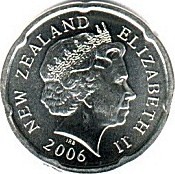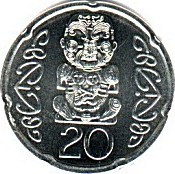New Zealand twenty-cent coin facts for kids
| New Zealand | |
| Value | 0.20 New Zealand dollars |
|---|---|
| Mass | 4.00 g |
| Diameter | 21.75 mm |
| Thickness | 1.56 mm |
| Edge | "Spanish flower" |
| Composition | Nickel-plated steel |
| Years of minting | 2006–present |
| Catalog number | – |
| Obverse | |
 |
|
| Design | Queen Elizabeth II |
| Designer | Ian Rank-Broadley |
| Design date | 1999 |
| Reverse | |
 |
|
| Design | Māori carving of Pukaki, a chief of the Ngāti Whakaue iwi |
| Designer | Robert Maurice Conly |
| Design date | 1990 |
The New Zealand twenty-cent coin is a coin from New Zealand. It is worth 20 cents, which is a small part of a New Zealand dollar. This coin first came out on 10 July 1967. It took the place of an older coin called the florin.
At first, the coin had a picture of a kiwi bird on one side. But in 1990, the kiwi picture moved to the one-dollar coin. So, the 20-cent coin got a new design. In 2006, the coin became smaller. Its edge also changed to a special shape called a "Spanish flower". The coin's material changed too, from cupro-nickel to steel with nickel on top.
Contents
Coin Design Over Time
The look of the 20-cent coin has changed a few times since it was first made.
First Design: 1967 to 1990
On 10 July 1967, New Zealand changed its money system. They switched from pounds to dollars. One pound became two dollars. The 20-cent coin replaced the florin coin. The florin was worth two shillings.
Like the florin, the first 20-cent coin was made of a metal mix called cupronickel. It was about 28.58 mm wide and weighed 11.31 grams. Its edge had many small ridges. The coin kept the kiwi bird design that was on the florin, but it was a new drawing.
The front side of these coins showed a picture of Queen Elizabeth II. This picture was designed by Arnold Machin. In 1986, the Queen's picture changed to one by Raphael Maklouf. Coins made with this new picture in 1990 are quite rare.
New Design: 1990 to 2006
In 1990, New Zealand started using new $1 and $2 coins. These coins replaced the old $1 and $2 paper notes. Since the new $1 coin also had a kiwi bird, the 20-cent coin needed a new design.
The new back side of the 20-cent coin showed a famous Māori carving. This carving shows Pukaki. He was an important chief of the Ngāti Whakaue iwi (tribe) from Te Arawa.
In 1999, the Queen's picture on the front changed again. This time, it was a design by Ian Rank-Broadley. No 20-cent coins were made between 1991 and 2001. The older 20-cent coins stayed in use. There were many more of them than the new design until 2006.
Smaller Coin: 2006 Onwards
On 31 July 2006, a new, smaller 20-cent coin came out. This was part of a big change by the Reserve Bank of New Zealand. They called it "Change for the better." New 10-cent and 50-cent coins also came out at this time.
The new 20-cent coin had the same Pukaki design on the back. It also had the same Queen's portrait from 1999 on the front. But the coin was much smaller. The new coins are made of steel with layers of nickel on top. They are 21.75 mm wide and weigh 4 grams. Their edge has a special "Spanish flower" shape, which means it has seven smooth sections.
In 2006, 116 million of these new coins were made. This was worth NZ$23.2 million. The only other year they were made was 2008, when 80 million coins were produced.
The old, larger 20-cent coins stopped being official money on 1 November 2006.
The Future of the Coin
After Queen Elizabeth II passed away in September 2022, the Reserve Bank said they would keep using their current coins. They will only start making new coins with King Charles III on them once they run out of the old ones. This will likely take several years.
How Many Coins Were Made
The Reserve Bank of New Zealand keeps track of how many coins are made each year. The values below are in New Zealand dollars.
- No large 20-cent coins were made in 1968, 1970, 1991–2001, or 2003.
- Because so many small 20-cent coins were made in 2006, none were made in 2007 or from 2009 onwards.
- 1967: $2,600,000
- 1969: $500,000
- 1971: $320,000
- 1972: $303,000
- 1973: $610,000
- 1974: $907,000
- 1975: $1,000,000
- 1976: $1,500,000
- 1977: $1,500,000
- 1978: $500,000
- 1979: $1,600,000
- 1980: $1,800,000
- 1981: $1,500,000
- 1982: $3,500,000
- 1983: $500,000
- 1984: $300,000
- 1985: $1,200,000
- 1986: $2,500,000
- 1987: $2,800,000
- 1988: $2,500,000
- 1989: $1,000,000
- 1990: $1,000,000
- 2002: $1,400,000
- 2004: $1,700,000
- 2005: $800,000
- 2006: $23,320,000
- 2008: $16,000,000
See also

